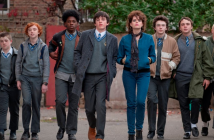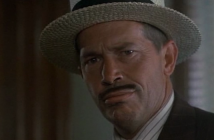Editor’s Note: The following review is part of our coverage for TIFF’s Notorious: Celebrating the Ingrid Bergman Centenary. For more information on this TIFF film series visit http://tiff.net and follow TIFF on Twitter at @TIFF_NET.
Ernest Hemingway, it’s been told, hated the Hollywood game, once noting that the best way to negotiate with studios was to set up a meeting at the California border: “You throw them your book, they throw you the money, then you jump into your car and drive like hell back the way you came.” Despite his lingering hatred of Hollywood and all it stood for, Hemingway seemed to almost revel in his relationship with both studios and the press during production of For Whom the Bell Tolls (1943). He’d been thinking about film rights from the moment he started writing the novel in 1939; he had his pal Gary Cooper in mind for the lead from the very first pages, and as soon as he had seen Ingrid Bergman in Intermezzo: A Love Story (1939), he knew she had to play Maria.
Bergman is light and airy at times, like a teenager experiencing her first crush, and hardly resembles the Maria of the novel.
Bergman may have been Hemingway’s first choice to play the young girl who falls in love with an American fighting for the left-wing Republicans in Spain, but she was not the first actress cast. Ballerina Vera Zorina, a unique and ethereal beauty, had been given the role, but as Bergman’s biographer Donald Spoto noted, neither Gary Cooper nor director Sam Wood liked working with her. She was replaced with Bergman, and Hemingway, apparently without hesitation, made the rounds of the entertainment media to put a good spin on this quickie cast change. Photos of the novelist and actress appeared in all the major papers, Hemingway positively beaming, with no sign of the man who wanted to “drive like hell” away from Hollywood.
 Set in Spain in 1937, For Whom the Bell Tolls follows the exploits of rugged man’s man Robert Jordan (Cooper) and his mission to dynamite a bridge in an effort to fight the fascists during the Spanish Civil War. Sent to the mountains located near the bridge, Robert meets up with a small gang of leftist guerrillas, including the elderly Anselmo (Vladimir Sokoloff), the untrustworthy Pablo (Akim Tamiroff), and the group’s leader Pilar (Katina Paxinou). Also with the group is the young Maria (Bergman), found by Pablo as she was hiding from the fascists who had raped her and murdered her parents. The moment Robert sees Maria he falls for her, and she, in turn, falls for him.
Set in Spain in 1937, For Whom the Bell Tolls follows the exploits of rugged man’s man Robert Jordan (Cooper) and his mission to dynamite a bridge in an effort to fight the fascists during the Spanish Civil War. Sent to the mountains located near the bridge, Robert meets up with a small gang of leftist guerrillas, including the elderly Anselmo (Vladimir Sokoloff), the untrustworthy Pablo (Akim Tamiroff), and the group’s leader Pilar (Katina Paxinou). Also with the group is the young Maria (Bergman), found by Pablo as she was hiding from the fascists who had raped her and murdered her parents. The moment Robert sees Maria he falls for her, and she, in turn, falls for him.
Cooper’s usual understated style hinders his performance in For Whom the Bell Tolls, and his Robert displays none of the passion one would expect from an American who traveled halfway across the world for a cause that most people in the United States hardly understood, let alone cared about. Bergman reportedly wanted the role of Maria badly, but one can’t help but feel she was miscast as the Spanish girl reeling from acts of unspeakable violence. Bergman is light and airy at times, like a teenager experiencing her first crush, and hardly resembles the Maria of the novel.
Had Bergman portrayed Maria with a more accurate demeanor, the glossy sheen of this particular big-budget Hollywood blockbuster would have cracked and a little reality seeped in.
It’s been speculated by biographers and film writers alike that Hemingway’s (mostly unofficial) power over the production was one reason for its middling reception from critics. While it’s true he enjoyed far more influence over the adaptation of his novel than most authors, the real problem with the film was the same problem pretty much every film of the era had: the censors. Paramount and the Hays Office were concerned not only with the politics of the book, but with the sexual affair between Robert and Maria.
It turned out that the sex was far less prickly than the politics. The script was rewritten, leaving most of the love affair intact, though portrayed by innuendo and stunning visuals. But this script also turned what had been a complicated criticism of war into a pro-war film. This was not a surprise considering the United States was embroiled in World War II at the time; what was a surprise was that almost every reference to fascism or specific countries, most notably the Soviet Union, who had supported the anti-fascists in Spain, had been removed. Still, Paramount, in what could hardly have been a coincidence, cast no less than five Russian-born actors in the roles of the anti-fascists.
But, as James Agee said in his fantastic review in The Nation, “if you are not careful, you may easily get the impression that Gary Cooper is simply fighting for the Republican Party in a place where the New Deal has got particularly out of hand.” Agee also tackles in his review the problem of Ingrid Bergman, who is beautiful, even radiant, as the androgynous Maria, but who at no point behaves like a young woman who is still recovering from a brutal gang rape and the savage murder of her parents right in front of her.
As unfortunate as it is to say, Bergman’s performance is, at times, flat out embarrassing, especially when compared to a stellar supporting cast. Katina Paxinou would go on to win the Academy Award for Best Supporting Actress for her fine performance as Pilar. Paxinou, along with Akim Tamiroff, do all of the heavy lifting when it comes to passion, emotion and drama; Joseph Calleia and Lilo Yarson also elevate the material with deft performances in smaller roles.
But Bergman’s and Cooper’s performances were inadequate, though much of the problem was with Hollywood itself, too afraid (and frequently unable, thanks to censors) to tackle difficult issues. Had Bergman portrayed Maria with a more accurate demeanor, the glossy sheen of this particular big-budget Hollywood blockbuster would have cracked and a little reality seeped in. That just couldn’t happen, not during World War II, and especially not in For Whom the Bell Tolls, which was always meant to be the kind of film where people make grand, lyrical pronouncements as they stare off in the distance while meaningful music plays in the background.
For Whom the Bell Tolls is not reality and it’s not poetry, but rather high-functioning kitsch, a film that hot glued some Gone With the Wind visuals and Casablanca romantic sensibilities onto a Hemingway novel and called it art, and knew that much of the public would take their word for it. A financial hit in its day, if not a critical one, For Whom the Bell Tolls in retrospect feels like a movie that very much wanted to be ahead of its time but, like so many scientists in so many science fiction spoofs, thought that the future was simply bigger, shinier versions of what everybody already had.
A financial hit in its day, if not a critical one, For Whom the Bell Tolls features some fantastic supporting performances and stunning visuals, but turns what in the novel was a complicated critique of war and redemption into a generic, bland romance.



